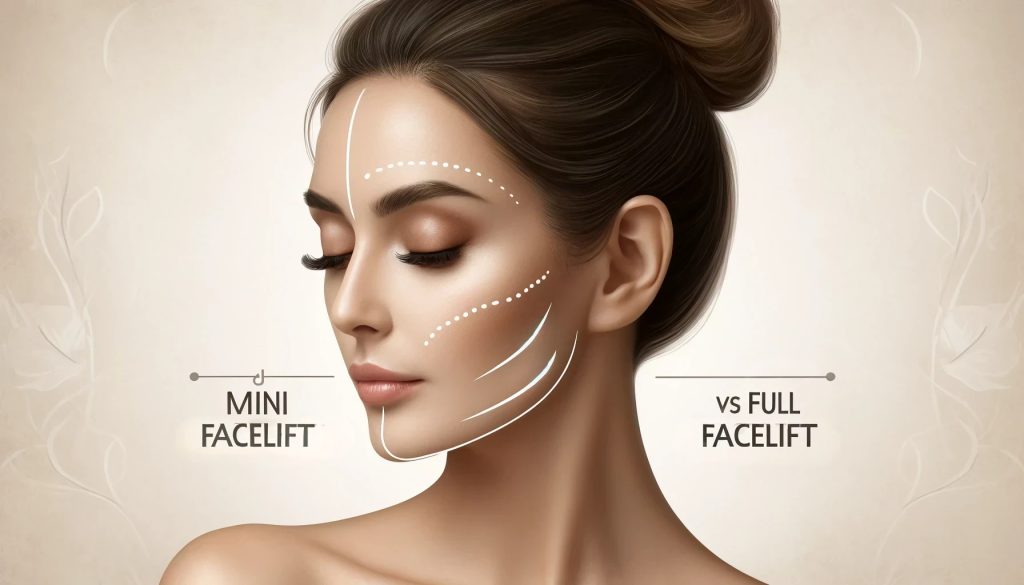Maybe you have spent years trying creams and non-surgical procedures such as Botox and fillers, and you are tired of having to go back to improve the signs of aging. While certainly, following a quality skin care routine and trying non-surgical facial rejuvenation options helps to maintain a youthful appearance, there comes a time when these can no longer provide you with the results that you are looking for. Perhaps, you are ready to try something more effective and long-lasting to rejuvenate your face, lift the cheeks and smooth out deep lines. If a possibility of getting a mini facelift or full facelift has crossed your mind, but you are still feeling a bit uncomfortable with the idea of surgical rejuvenation and are overwhelmed by the multitude of different facelift types, you should keep reading.
When considering the options for surgical rejuvenation, the most important question to answer is whether a Facelift is the right choice in the first place. If you are still in the early stages of the aging process, you may still benefit from non-surgical rejuvenation procedures. Here is a simple test that will help you determine whether the facelift is the right procedure for you. Once you’ve determined that you are a possible candidate for a facelift, the next important question to answer is what type of facelift should you consider.
Types of Facelifts
Over the years a great variety of different types of facelift were developed. Some of them are used continuously be many surgeons and some could be quite outdated and hardly used at all. To make matters even more confusing the same types of facelifts could be called by several different names (see facelift terminology).
in order to recapture the youthful look you would need to get rid of the skin laxity and lift , it is important to consider what type of facelift will suit you the best. While there are many different types of facelifts, this post will focus on addressing the differences and advantages between the mini facelift and the full facelift. a minimally invasive procedure that yields beautiful results with a relatively fast recovery time.
The Full Facelift
A full facelift, as you may guess, addresses the more obvious signs of aging; it is often done in conjunction with a neck lift. It improves the entire lower two-thirds of the face and the neck. The full facelift is also minimally invasive with many patients returning to work in just two weeks. The expected procedure time is between two to four hours and the results – although it should be noted that everyone is different – typically last up to 10 to 15 years. Thanks to modern surgical facelift techniques, the full facelift results in a dramatic, but totally natural-looking that avert the “pulled” appearance.
The Mini Facelift
Another type of facelift, is the mini facelift that often attracts patients ranging from 30 to 40 years of age with early signs of aging. The mini facelift can give you a more youthful appearance by: restoring fatty tissue over the cheekbones, restoring jawline definition, tightening mildly sagging skin between the nose and cheeks and fixing the early formation of jowls. The procedure, which lasts about two hours, is also minimally invasive; it requires incisions at the hair tufts next to the ear, that are then closed with small sutures. Because the mini facelift involves much shorter incisions, its results are much more subtle than that of a full facelift and the results lasts about 5 to 10 years.
How to Decide Between Mini Facelift and Full Facelift
If you are still unsure whether a full or mini facelift procedure is right for you before scheduling a consultation, you can try doing the mirror test. In front of a mirror with just your index fingers, simply pull back lightly on the skin where your jawline meets your ear. If the sagging skin disappears, and you like what you see, then a mini facelift is probably the right choice you. If instead, you find yourself using multiple fingers to pull back the sagging skin from your neck and face, then you are better suited for a full facelift since a mini facelift alone will not be sufficient to correct these problem areas.
I had the pleasure to talk with Dr. Vasyukevich, a double-certified facial plastic surgeon, who has performed more than 2,000 facelift procedures. Dr. Vasyukevich explained how he analyzes a patient’s face and determines the best approach to get the appearance that the patient desires based on their appearance and features. In addition, we also talked in depth about the full and mini facelifts that he performs at his New York City office and some of the most common questions that patients have regarding facelifts.
Advice from Facelift Expert Dr. Konstantin Vasyukevich
Me: Why doesn’t the mini facelift last as long as the full facelift?
Dr. V: “It’s the magic behind the facelift that is also why the mini facelift does not last as long as the full facelift. Dr. Vasyukevich explains, “The mini relies on the tissues pulling on the underlying SMAS, whereas the full repositions the tissue without pulling it. Repositioning minimizes the force of tissue recoiling back to its’ original position.”
*The magic of today’s procedure lies in the very technical term: Superficial Muscular Aponeurotic System (SMAS) technique. Aponeurotic is a fancy, technical term for binding muscles together so they can be attached to bone (Wikipedia). The connective tissue, which is located at a deep layer underneath the skin, is repositioned and the skin just follows. In this way, the contour or shape of the face looks rejuvenated. This is important because as we age we lose the contours and curves as the tissue becomes more lax.
Me: When patients come to you do they usually know that they need or want a facelift or do they figure it out with you during the consultation?
Dr. V: People generally have an idea that they need or want a facelift before they consult a doctor. “Typically people already know because you don’t go to a surgeon thinking you might need surgery,” explains Dr. Vasyukevich. “A lot of times they hope they don’t need it and there might be other options. They want to know what other options are available to them; they want to know everything.
On the other hand,” he continues, “there is a subset who know exactly what they want. Usually they have been doing nonsurgical procedures such as fillers and/or tightening for many years. After leaving no stone left unturned, and after exhausting all of their other options, they want to do something surgical. They want to see permanent results. Again, this is just a subset of patients.”
Me: When I think of a facelift, I think of the face looking like it’s tightly, unnaturally pulled back, leaving an expressionless look; what’s the most important thing that you do during a procedure to be sure that the patient’s skin doesn’t look tightly pulled?
Dr. V: “The treatment was very different than it is today because surgeons stretched the skin tightly. Patients were getting two to three years out of their facelifts. Later on, so that patients could get more longevity out of their facelifts; skin was pulled tighter for a facelift that would last for three to five years.”
Me: How old are patients that get a mini/full-facelift? 20s? 30s? 40+?
Dr. V: There is no set age range for people that get facelifts. Some patients are in their 50s, and some as early as their 30s need a more complete procedure. Genetics and environmental factors play a role. Sun exposure and smoking are the biggest risk factors for aging.”
Me: When do you add fillers after the facelift?
Dr. V: “It’s important to note that volume is not restored through a facelift alone. That’s why patients that do a full facelift also ask to add fat to their face for volume. Consumers are very educated. Many of my patients talk to me after reading about fat grafting. Depending on their facial structure, some would benefit and some would not. This is something that gets discussed at their consultation or prior to the procedure.”
“Fillers are typically added after the facelift, when healing is complete and the swelling goes down. Everyone is different, but the usual timeline for filler is about four to six weeks after the procedure. “Sometimes we do fillers during procedure because people don’t like the pain. But it’s best to add filler after the swelling goes down instead of during the facelift procedure.
Take Your Next Steps
If you are still unsure whether a full or mini facelift procedure is right for you, Dr. Konstantin Vasyukevich and his team can help you create a customized facial rejuvenation treatment plan in order to restore a more youthful and beautiful complexion. To schedule a consultation, please do so through our consultation calendar or call us at 212-380-3634.



Leave a Reply